Cultural Agility Challenge
Overview
This concept project envisages a global biopharmaceutical client called Evolvise, based in the UK. The scenario-based e-learning project is designed to help managers sent to Thailand from Evolvise's headquarters in London to develop skills that will have a positive impact on working relationships with their Thai staff. Throughout the course, the learner experiences the consequences of certain actions and behaviours in an unfamiliar cultural context through a series of real-life, low-risk scenarios. Throughout the scenario, optional on-demand cultural agility content supports the learner's decision-making process.
Responsibilities
Instructional Design
E-learning Development
Research & Content Curation
Needs Analysis
Script & Storyboard
Visual Design
Audio Production
Quality Assurance Testing
Audience
Mid-level managers from a UK-based company sent to Bangkok, Thailand.
Tools
Adobe Photoshop & Express
Articulate Storyline 360
Audacity
DALL-E2
Miro
Narakeet TTS
PowerPoint
Twine
Language
English (UK)
THE CLIENT‘S PROBLEM
Globalisation is driving business expansion into new foreign markets, requiring companies to send expatriates to fill management positions abroad. Expatriate assignments can be challenging. It is not uncommon for expatriates to fail to meet their objectives. As a result, projects are often left unfinished, which can result in significant losses for an organisation. Failure of expatriates to deliver is not only costly for companies but can also have a negative impact on the company's reputation and ruin relationships with local partners. It is therefore crucial to identify the criteria that can contribute to expatriate success.
One of the attractive new markets in which many multinationals are looking to establish themselves is Thailand. Thai culture is multi-faceted and complex, and there are significant differences between Thai and expatriate business etiquette and cultural values. Evolvise's Bangkok office was established in 2018, and since then many employees have been sent on assignments to Thailand. However, Evolvise has noticed that its expatriate managers have repeatedly failed to achieve their goals. Evolvise wants its employees to gain a deeper understanding of Thai values to work more effectively and efficiently in a very different cultural environment.
THE SOLUTION
Cultural agility is a competency that enables professionals to perform successfully interculturally. However, it is not an easy skill to train. Acquiring culturally agile behaviour will vary greatly depending on a manager's career stage, professional goals, previous experience abroad, personality traits, tolerance, resilience, language skills and their overall ability to adapt cross-culturally [1,2].
It was clear to me that a well-designed cross-cultural training programme must be tailored to the specific needs of the learner in order to benefit an organisation. Intercultural competence has been defined as a set of cultural knowledge, behaviours and attitudes developed through an ongoing process of training and experience that provides the ability to operate effectively in interactions with other cultures [3]. This definition implies that the mere transfer of knowledge is not sufficient and that the development of specific skills and abilities must also be considered. In addition to knowledge of the norms, attitudes and values of the host culture, it is crucial for managers to learn from experience and to be prepared for situations and emotions that may arise when interacting with an unfamiliar culture.
I decided that the ideal solution to this problem would be self-paced e-learning, with its strong potential for branching scenarios and tailored feedback. Expatriate managers sent to Thailand not only need to be aware of cultural differences, they also need to practice and become comfortable with using culturally appropriate strategies. According to Knowles' theory of andragogy, adults are moving from subject-based learning, which focuses on simply knowing a concept, to problem-based learning, which focuses on knowledge that contributes to solving problems. Scenario-based learning provides an excellent platform for practising problem-solving skills while avoiding costly mistakes in the workplace [4]. Self-paced e-learning also has the advantage for the client that the course can be delivered to managers in different locations whenever someone is oing to be on assignment in Thailand. This concept project was designed as the first part of a cultural agility course, with the full training programme including different modules and discussion opportunities.
The overall project management structure was loosely based on the ADDIE framework, although several iterative steps were included during the design and the development phase. However, in contrast to ADDIE, my main approach to the project was to prioritise the intended learning outcomes. As a result, the sequence of events followed more closely the backward design model [5] and Cathy Moore's action mapping process [6]. In addition to these well-known ID frameworks, aspects of human-centred design and behavioural insights were also taken into account. Apart from general principles of andragogy, I based my design choices for the project mainly on the AGES learning model7, influenced by neuroscience research, and social learning theory [8].
The result is a complex branching scenario with a story-driven approach. The scenario is complemented by optional content such as a detour providing background information on Thai cultural values, further feedback on decisions, advice from a mentor character and a job aid. I decided to design the learning experience to adapt to the learner's stage of cultural agility by giving the learner control over what and how much additional content they would like to access.
THE PROCESS
1. Needs Analysis
Target audience profile
The target audience for this course are mid-level managers from Evolvise's UK headquarters who are being sent on assignment to Bangkok, Thailand. Statistics indicate that the majority of mid-level managers in the UK are males in their 40s. It is to be expected that the audience will vary greatly in terms of their previous knowledge of Thailand, of Thai culture, or of cultural agility skills in general. While some managers may have acquired some basic knowledge through travel or previous assignments in other countries, others may be completely inexperienced in dealing with cultural differences. When designing for such a heterogeneous audience, it makes sense to offer additional content to the learner on demand, rather than imposing all content on all learners equally.
Research and content curation
I first identified and contacted a suitable SME for the topic. Prof. Jia Hui Lee (Assistant Professor of Anthropology) agreed to assist me with this conceptual project and provided me with initial materials.
After identifying appropriate keywords, I conducted an extensive literature search in psychological, economic and social science databases (e.g., PsycINFO, Web of Science, EconLit, Google scholar). I included research articles, case studies, books, book chapters and blog posts. Materials recommended by the SME were also included in this initial evaluation. Titles and abstracts of all materials were pre-screened for inclusion. Relevant content of the included literature was extracted and summarised. This final summary was then presented to the SME for approval and used as the basis for the action map.
In preparation for the action mapping process, I conducted an interview with a German manager who had worked as an expatriate in Bangkok. It was important for me to get some first-hand descriptions of potential problems that could arise from cultural misunderstandings. The interview also helped to identify potential consequences of mistakes. Although there are minor cultural differences between the UK and Germany, the insights gained from this interview were very valuable to the design process and storyline development of this project.
Action Map
The complexity of the culture theme required a two-step process. Guided by Cathy Moore's strategic action mapping process [6], I first identified key variables and actions contributing to the overall performance problem (Problem: Expatriate managers often fail to meet assignment objectives; Action Map 1). A manager's ability to work well with Thai employees was identified as the most important skill based on the literature reviewed and hence improving this skill served as the overall learning objective. I then determined a measurable performance goal for the learning experience (Goal: Improve overall assignment success by 30% as expatriate managers work better with Thai employees; Action Map 2). Observable tasks and behaviours that learners would need to perform and avoid to achieve the performance target were identified through a brainstorming session with the SME. Next, I analysed all the behaviours and determined their mutual influence. Finally, the behaviours were ranked according to their contribution to achieving the business objective. This analysis revealed 3 high priority behaviours that became the focus of the learning experience content and guided my design process. The behaviours are marked with a blue frame in Action Map 2. Both action maps were generated using the app Twine.
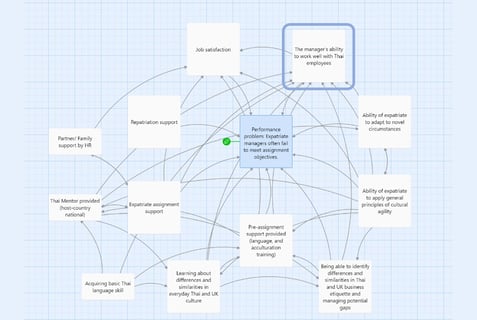

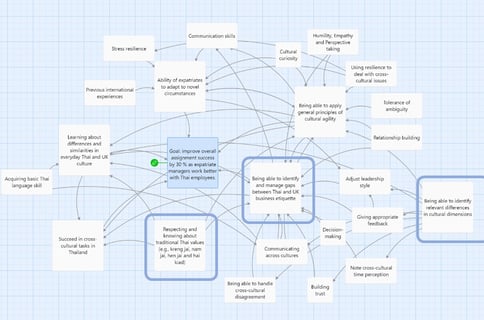

Action map 1. The most important skill is marked by a blue frame.
Action map 2. Key behaviours that contribute most to achieving the business objective are marked by a blue frame.
Will training help?
According to Cathy Moore [6], training is not always the best solution. Other issues (e.g. environmental or motivational problems in the organisation) need to be addressed first. Whether employees' specific skills and knowledge are essential to solving the business problem is a strong predictor of the success of a training programme. Cultural agility is a complex and multifaceted issue [1]. To develop a culturally agile mind, a learner needs to develop and refine skills to identify and manage relevant cultural differences, but also to be aware of and manage their own personality traits such as cultural curiosity, resilience or tolerance. In addition, a minimum knowledge of the host culture and its business etiquette is essential to help a manager succeed. However, the action mapping process revealed that mere knowledge of cultural differences, which can be provided in a job aid (see section below), is not sufficient. In addition to being aware of gaps in business etiquette, it is even more important to be able to apply this knowledge appropriately and correctly identify situations where cultural sensitivity should be used, as opposed to situations where it would be necessary to put the needs of the organisation or the success of the project first.
It is well known from health professions education research and behavioural insights into self-motivation and intention that knowledge alone is never enough to change behaviour [9, 10]. This discrepancy between attitude or intention and actual behaviour is known as the intention-action gap [9]. For example, it has been shown that educational interventions that successfully increase clinicians' knowledge still fail to have a significant impact on clinician behaviour and health care outcomes[10]. In the current scenario, knowledge of cultural differences and culturally agile behaviour does not necessarily mean that the correct behaviour will be applied appropriately in the cultural context. This concept project was designed to be the start of a series of online modules on cultural agility and Thai culture that would include branching scenarios, quizzes, but also forum discussions and a final assignment. I felt that a branching scenario would be the best choice here, as scenarios help people to pick up on subtle cues and to shift their perspective in complex situations of social interaction.
I considered the option of face-to-face training combined with self-paced e-learning modules. However, this would not have been a cost effective and feasible solution as the managers sent to Thailand may be from different locations and face-to-face training would involve travel and accommodation costs. Another important factor was the timing of the learning programme, as it is conceivable that not all managers will be sent abroad at the same time. As a result, the best option was the self-paced e-learning scenario, combined with discussion opportunities.
2. Design Process
Design decisions influenced by Adult Learning Theory
The design of the present e-learning project has been mainly influenced by the principles of Malcolm Knowles' theory of andragogy [4], the AGES learning model and social learning theory. It also contains elements of behaviourism, constructivism and cognitivism. As AGES and social learning had the greatest impact, these aspects will be discussed in detail below.
The project was heavily influenced by the AGES learning model, which is based on neuroscience research. The AGES model was first described by a team from the NeuroLeadership Institute. The authors suggest that an increased awareness of how the brain works can guide the development of appropriate, informed leadership and learning strategies [7, 11]. The model incorporates four key neuroscientific principles that influence the brain's memory systems and thus promote learning in adults that lasts: Attention (A), Generation (G), Emotion (E), and Spacing (S) [7].
Attention: Undivided attention to new material is essential for long-term learning. The learner needs to focus on the material in order for the hippocampus to be sufficiently activated. Managing a learner's attention may be easier in a classroom than in self-paced online learning, where learners are often surrounded by their own personal distractions. The ability to focus depends on an extensive network of brain regions and neurotransmitter systems, including the dopaminergic system [7]. Increasing dopamine levels in a learning situation requires that the content is relevant, that is, that the learner sees the value in focusing on the content. This can be achieved, for example, by making learning scenarios as realistic and personal as possible, which was considered in the design of the present scenario. It is also important to recognize that attention tires and drifts approximately every 15 to 20 minutes. To maintain focused attention, it is important to keep the learning units within this time span, which was also taken into account in the design of the cultural training. The main training module does not take longer than 20 min. Even if a learner decides to spend more time by choosing the detour at the ‘Tuk-Tuk Station’, breaks are encouraged.
Generation: Generation refers to the learner's ability to make their own connections to new material or ideas presented. Studies show that the key to optimising learning and building long-term memory is to create 'ownership' of learning content. This requires the learner to understand, contextualise, retain and apply knowledge in their own personal way [7]. One way of generating associations is to encourage the learner to evaluate the meaning of the information presented and compare it with their existing knowledge. In the present learning experience, the learner is presented with optional information about Thai cultural values (job aid, detour to explain cultural values, additional feedback, and advice from the monk) which must then be applied to correctly solve the realistic scenarios. This allows all learners to draw on their personal knowledge of Thai culture or cultural agility skills in general. In this way, rather than being imposed on everyone, the information is available and can be actively drawn upon by the learner, which helps to form personal associations.
Emotion: Emotions are important modulators of learning and memory. Emotional arousal promotes focus and attention and can signal the importance or salience of a particular event, which subsequently facilitates the effectiveness of memory encoding. Notably, this works particularly well with negative emotions. However, this can be counterproductive, as negative emotions reduce creativity and innovation and can promote aversion to the learning experience [7]. A good aim, therefore, is to associate positive emotions with the learning experience rather than making it a compulsory event. For the present scenario, the main character has been designed to evoke positive emotions as he is a bit goofy, naive but still relatable and likeable. In addition, several optional resources are available to the learner which can help to reduce performance anxiety and thus promote just the right level of emotion by avoiding over-arousal.
Spacing: Spacing refers to the distribution of learning sessions over time, as opposed to cramming as much information as possible into one long session (massing). Spacing has been shown to improve long-term memory and increase recall rates. Repetition itself has only a limited effect on creating lasting learning, whereas spaced repetition of new information supports the formation of long-term memory [7]. The present learning scenario is designed as the first module in a series of spaced learning modules that would have been developed subsequently. It serves as a prelude, providing the initial material and knowledge needed to develop cultural agility in the context of Thai business practices. The whole course would consist of several small learning modules on different topics, quizzes and an online discussion forum where the material can be further discussed. However, the design of the present scenario allows for spacing even within this first module by using different shortcuts. The learner can skip certain sections. This encourages the learner to return to the scenario later without having to go through the same introduction and other redundant material. I also used nudging techniques and social proof to encourage learner to take breaks. At the same time, this approach reduces cognitive load by giving the learner more control over the amount of content they are exposed to.
Design of scenario characters
Main Character
I chose to write the scenario from a third person perspective rather than a second person perspective (you, as the learner). This allowed me to include the main character's thoughts and feelings, which may not necessarily match the learner's experience or behaviour in a given situation. The topic of cultural agility is quite complex. Learners may have different knowledge and skills in navigating cultural differences. A third person perspective can help to overcome some of the resistance a learner may feel when behaviour is portrayed that they would not display. This allows the scenario character to make mistakes that a particular learner might not make. Nevertheless, the observation of these mistakes and their consequences will contribute to the learning process through social learning.
The main character in this learning scenario is a white male manager in his 40s called Ian. Statistics show that this is exactly the average mid-level manager in British companies, and therefore probably closest to the target audience. If this scenario had been prepared for a real client, it would probably have included the choice of a female protagonist. Gender differences are a crucial factor in cultural agility training but can often be very complex. It may even make a difference whether a female manager interacts with a male or female colleague in the host culture. These aspects would have been further explored in close collaboration with the client's needs. My aim was to make the main character relatable and sympathetic, so that it would be easy for the learner to identify with Ian and wish him success.


Mentor Character
Throughout the learning experience, the learner will have access to a mentor character via a dedicated button. The mentor character provides guidance to assist the learner in answering questions, rather than providing the correct answer in the scenarios. It was important to me that this mentor character made sense in the context of the scenario. A Thai monk was an obvious choice for this project. Thai culture is heavily influenced by Buddhism. The official religion in Thailand is Theravada Buddhism, which is practised by over 95% of the population [12]. Many monasteries in Thailand offer 'monk chats' or meditation retreats for non-Thai speakers. A monk chat is a casual conversation you have with monks in their monasteries. You don't have to be Buddhist to join a monk chat. It's open to all religions, races and nationalities. It is therefore not unreasonable that a Thai monk could act as a sort of advisor. However, it was important to me that the portrayal of a monk as mentor in this learning experience was not perceived as offensive by anyone. I therefore confirmed this choice with my SME and my interviewee who had lived in Thailand. Both did not object. To create a believable connection between the main character Ian and the monk, I added another character (Emily) who has a business relationship with Ian and recommends the monk.
Main scenario character: Ian from London.




Mentor character. The Thai Monk Phra Ajahn Jitdhammo.
Design of scenario setting and background story
A global biopharmaceutical company, which I named Evolvise, was the imaginary client for this learning scenario. Ideas for the name were generated using Namelix, a business name generator. Interesting name suggestions were further analysed to ensure they were not in use or had an unexpected meaning in another language. The final name was based on a modification of one of Namelix's suggestions. Evolvise's headquarters were placed in London, UK. I also defined that Evolvise had been operating in Thailand since 2018. The background story created for the scenario introduces manager Ian, who is assigned to oversee the launch of a new pharmaceutical product in Thailand. The project requires Ian to relocate to Evolvise's offices in Bangkok and work with his new Thai staff. This scenario establishes that Ian is new to Thai culture and that he is motivated to succeed in his task as it could be a career move.
I also designed a Logo for Evolvise using Adobe Express. The Logo is used throughout the scenario and in the job aid.
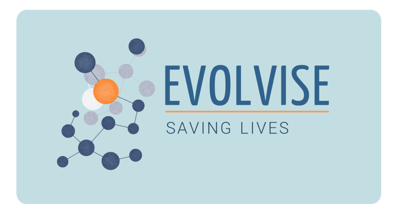

The Evolvise Logo.
Branching design
I first considered the idea of using mini-scenarios but then decided to use a complex branching scenario as it seemed the better fit. Mini-scenarios are good for covering a range of problem-solving activities, but they don't allow learners to go deeper into a complex situation. For this, complex branching scenarios are a better option. Here, learners' decisions early on can affect what happens in later scenes. This allows learners to challenge their own assumptions, recover from mistakes or deal with ambiguous situations [13]. The scenario takes place on Ian's first day at work in Bangkok. It covers the events around and during his first team meeting. Before developing the branching structure (see 3. Development), the potential mistakes and their consequences collected during the research phase were first sorted according to their relevance and contribution to the overall learning objective (=> Improving skills that positively impact on working relationships with Thai staff). To keep the complexity of the scenario manageable, I decided to use a branch and bottleneck structure for this branching scenario, instead of the traditional time cave structure [14]. I designed 3 bottlenecks in the branching structure, meaning that although I planned to branch into different options, all paths eventually return to these 3 decision points.
Visual design
Two mood boards were created using Milanote. One for the overall visual design of the learning experience (Mood board 1) and one for the Evolvise brand, including the Evolvise logo (Mood board 2). Both mood boards served as style guides for the learning experience and job aid respectively.
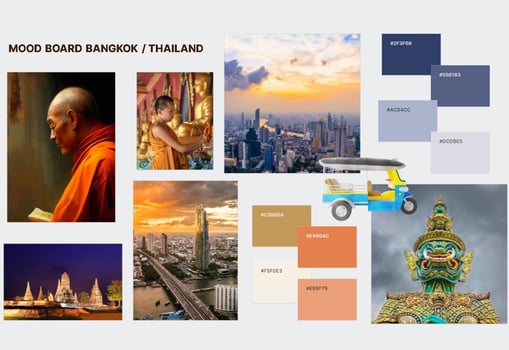

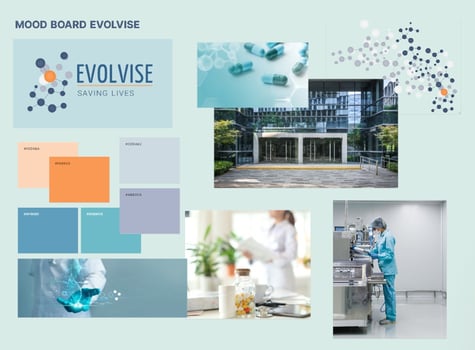

I then created visual mockups of each slide type and icon in Microsoft PowerPoint. After several iterations, the final versions were imported into Articulate Storyline 360.
Mood board 1. Bangkok / Thailand.
Mood board 2. Biopharmaceutical company Evolvise.
All graphics were edited using Adobe Photoshop and the AI photo editing software BeFunky. Most of the graphics were obtained from AdobeStock and Freepik through subscription plans. Where licenses were not purchased, the sources are listed in the ‘Resources’ section of the learning experience on the last slide. Some graphics were also created and edited using the DALL-E2 AI image creator (e.g., the Thai monk).
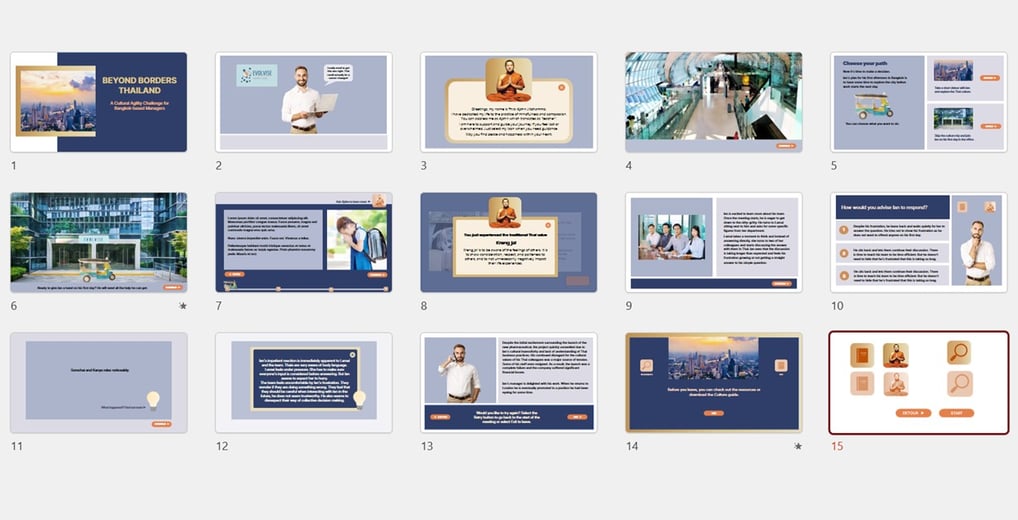

Visual mockups of the different slide-types, the icons and button design (last slide).
Sound design
Audio-visual (AV) learning refers to the delivery and use of instructional content that involves sound (auditory stimuli) and sight (visual stimuli). AV learning is commonly used to enhance comprehension, retention and transfer of learning [15]. The addition of another mode of communication can also enrich the learning experience. Throughout the introduction and the three different endings, narration is used alongside the presentation of paragraphs of text. This was done to implement aspects of AV learning and to improve accessibility. For the cultural detour and scenarios, I decided not to use narration to allow the learner to read the text at their own pace to enhance content comprehension or to take notes. Finally, to give the learner a more immersive and realistic experience, various Thai sound effects are used throughout the learning scenario.
Another strong influence was social learning theory [8], which emphasizes the role of observing and imitating others in the learning process. This theory applies for example when demonstrating proper workplace behavior. Managers can act as role models, demonstrating what is acceptable, and which consequences may follow certain behaviors. People who observe the behaviours, attitudes and consequences of others can use this information to shape their own actions. In my scenario, presented from a third-person perspective, the main character's actions and decisions serve as a learning opportunity for the audience. By witnessing the character's mistakes and their consequences, the learner can gain valuable insights and knowledge without having to experience those setbacks themselves. This approach taps into the power of observational learning, allowing the learner to benefit from the experiences of others and apply those lessons to their own lives.
3. Development Process
Job aid
Throughout the experience, the learner has access to a downloadable job aid, which is first introduced during the introductory section. This 'culture guide' is designed to provide the learner with the minimum information needed to complete the task. A job aid was considered essential as an additional option for this learning experience due to the complexity of the culture topic and the potentially serious consequences of not taking cultural values into account (e.g., failure to achieve project goals, employee resignation)[6]. The learner can download the job aid before exiting the learning experience. This feature makes the resource more accessible to the learner and helps them to continue their learning after the module has been completed.
For the development process I used an agile approach, which included multiple iterations and revisions of content, functionality, visual and audio design.
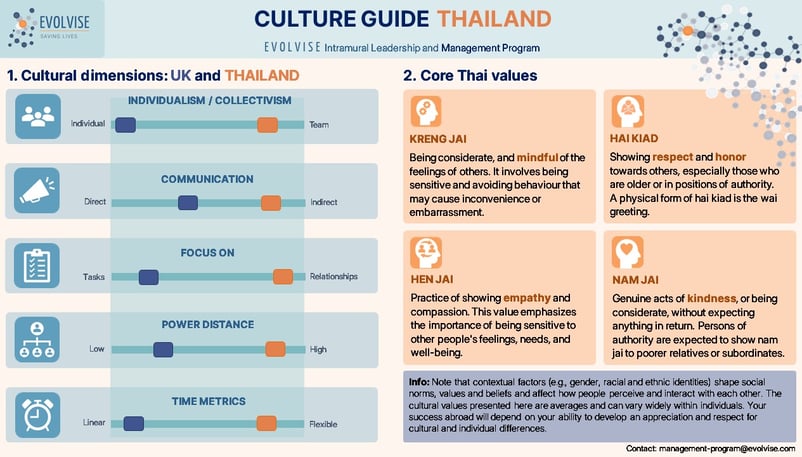

Job aid that the learner can access throughout the learning experience.
Script, Storyboard and Branching
I developed an initial script which was then reviewed by the SME.
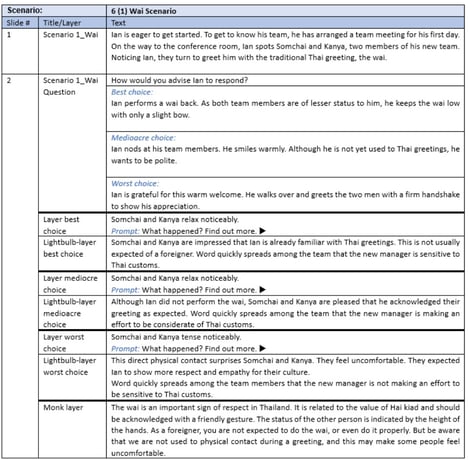

Sample excerpt from the script.
After incorporating the SME's feedback, I mapped out the branching structure using Miro. I started to develop the ideal path through the learning experience, which included 4 main decision points (3 bottlenecks). I then added several alternative branches and short detours. The paths cross at several points so that learners can practice recovering from mistakes. In this way, a bad choice doesn't necessarily lead to a bad ending or failure.
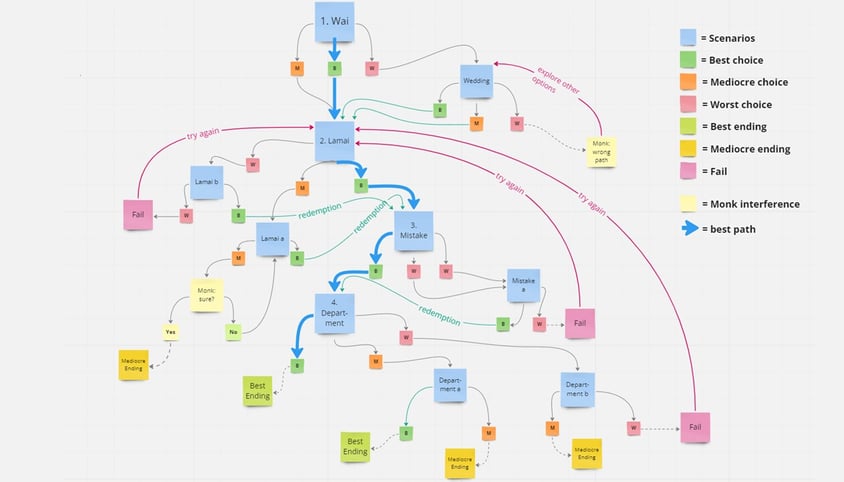

Next, I developed a text-based storyboard. The slide flow was visualised using Miro in parallel with the storyboard development.
Branching structure for the e-learning scenario.
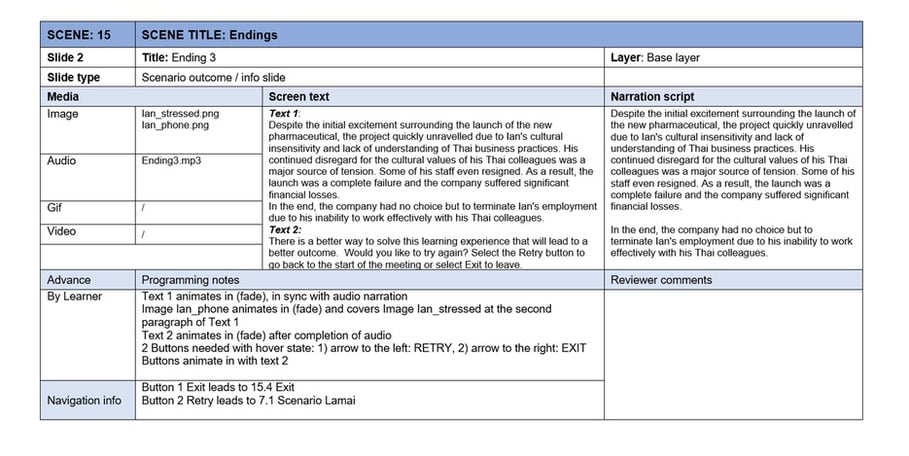

Sample excerpt from the storyboard.

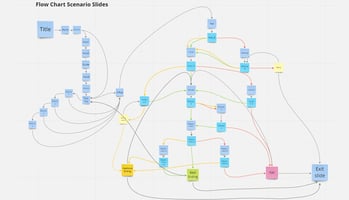
Overview of all scenario slides and their connections.
Interactive Prototype and Full development
After storyboarding, I developed a functional prototype in Articulate Storyline 360. This prototype was then tested with a focus group (n=10) of learners who had experience of work or living abroad. The prototype was also presented to the SME. Feedback and suggested revisions were then analysed and implemented in the learning experience. A revised version was presented again to the same group. It also included a more refined design. The final version was again presented to the SME for final approval. After the last revision, I did an extensive round of quality assurance testing before publishing the final version.

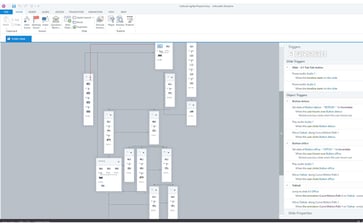
Story view of the entire project in Articulate Storyline 360.
REFERENCES
Caligiuri, P. and D. Caprar, Becoming culturally agile: Effectively varying contextual responses through international experience and cross-cultural competencies. The International Journal of Human Resource Management, 2022: p. 1-22.
Larios, A., Cultural Agility: Are You in Need of Developing Cross-Cultural Abilities for Your Executives? PM World Journal, 2021. X.
Caligiuri, P., et al., Assessing cross-cultural performance: beyond just “being there”, revisited. International Journal of Cross Cultural Management, 2022. 22(3): p. 413-431.
Knowles, M., The Modern Practice of Adult Education: From Pedagogy to Andragogy. 1970: Cambridge Book Company.
Wiggins, G. and J. McTighe, Understanding by design. 2nd ed ed., Alexandria, VA: Association for Supervision and Curriculum Development ASCD.
Moore, C., Map it: The Hands-on Guide to Strategic Training Design. 2017: Montesa Press.
Davachi, L., et al., Learning that lasts through AGES. NeuroLeadership Journal, 2010. 3.
Bandura, A., Social Learning Theory. 1971: General Learning Press.
Conner, M. and P. Norman, Understanding the intention-behavior gap: The role of intention strength. Frontiers in Psychology, 2022. 13.
Kennedy, T., et al., Exploring the gap between knowledge and behavior: a qualitative study of clinician action following an educational intervention. Acad Med, 2004. 79(5): p. 386-93.
Davis, J., et al., The Science of Making Learning Stick: An Update to the AGES Model. NeuroLeadership Journal, 2014. 5.
Wilson, T.Y.P., Exploring the challenges of Working with expatriates: A study of the socio-cultural Structure of the Thai business model. 2016, Manchester Business School.
Whybrow, L., Branching Scenario eLearning, in eLearning Industry (Blog; last accessed 10/05/2023). 2015.
Tucker, C., Branch and Bottleneck Scenario Structure, in Experiencing ELearning (Blog; last accessed 10/05/2023). 2019.
Podolskiy, O., Audiovisual Learning, in Encyclopedia of the Sciences of Learning, 2012, Springer US: Boston, MA. p. 384-386.








